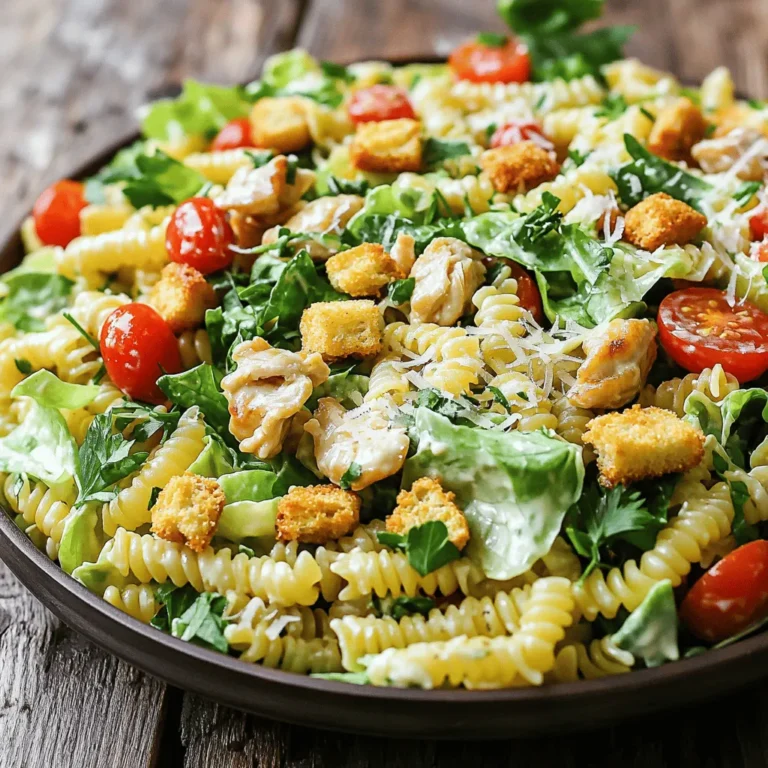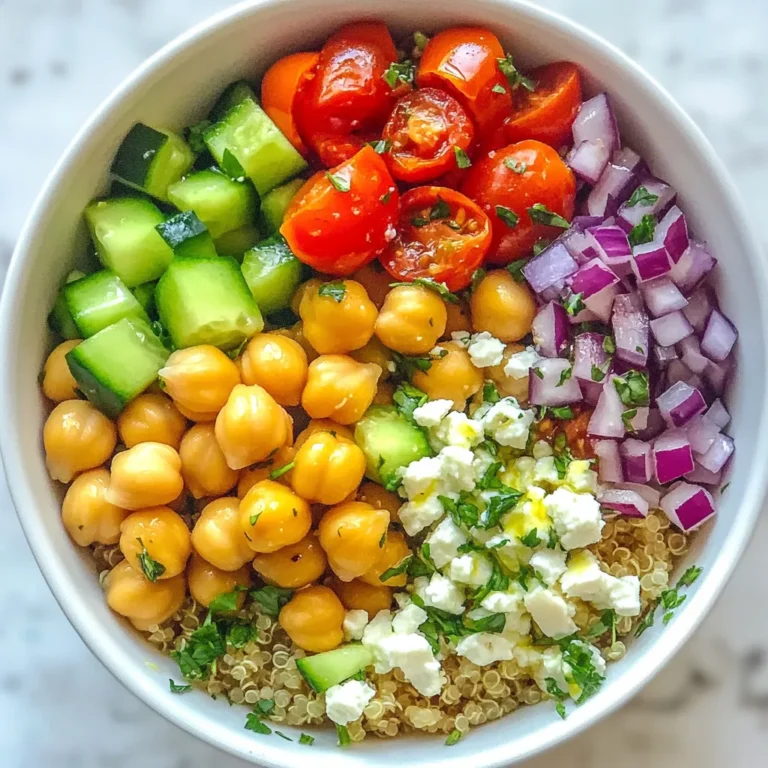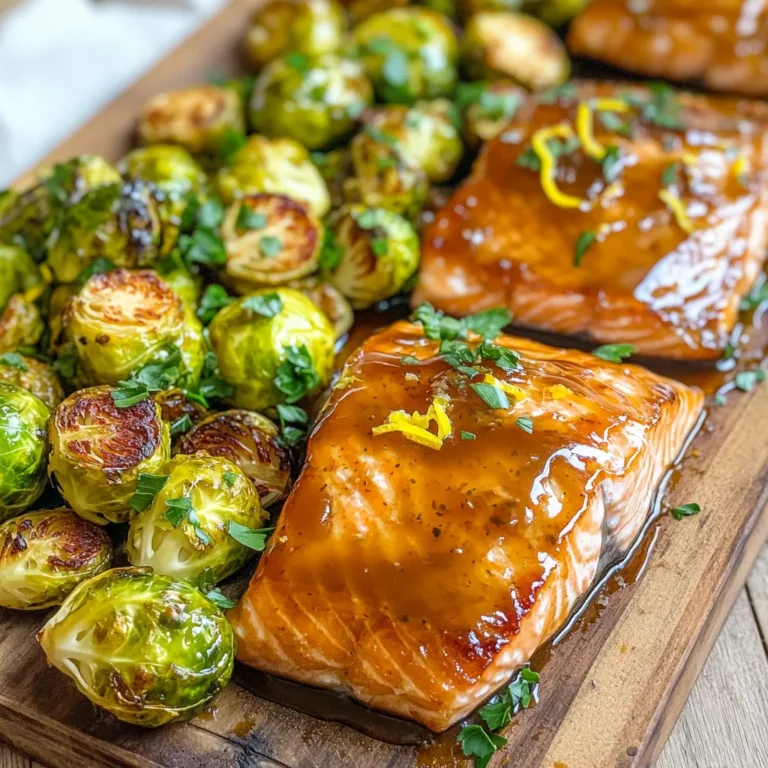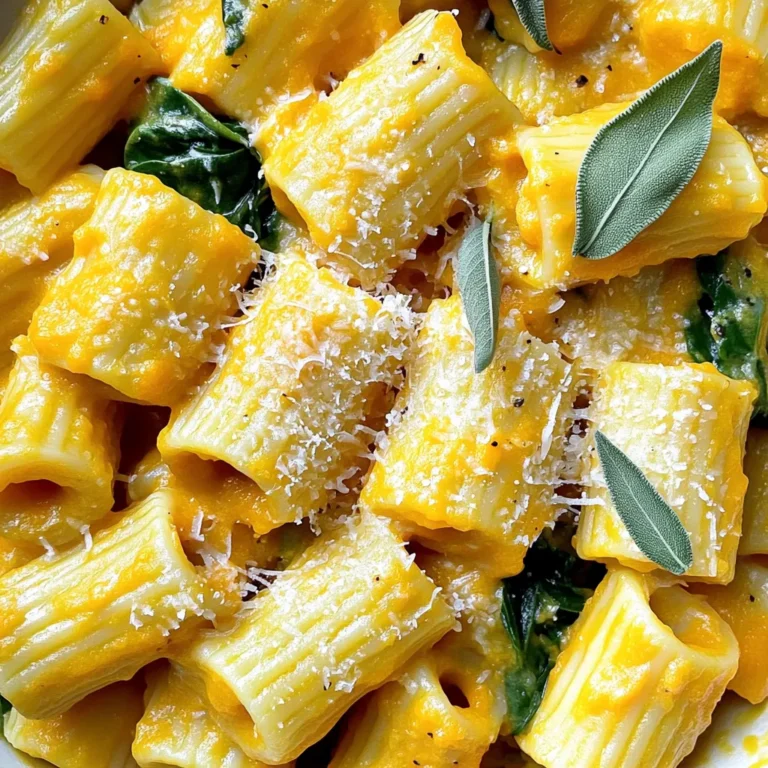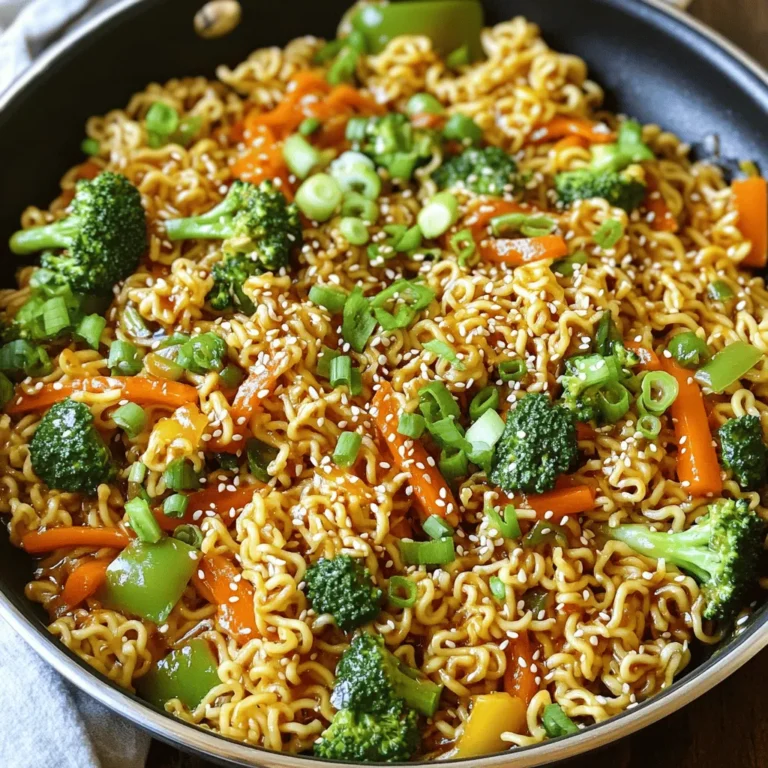Coconut Curry Ramen Bowl Flavorful and Nutritious Dish

Are you ready to elevate your dinner game? This Coconut Curry Ramen Bowl is not just tasty; it’s also packed with nutrients. In this post, I’ll share how to make a rich, creamy, and vibrant dish that’s easy to customize. Whether you’re a busy parent or a novice cook, I’ll guide you through every step to create a bowl of comfort that your family will love. Let’s dive into the ingredients and start cooking!
Why I Love This Recipe
- Quick and Easy: This dish comes together in just 30 minutes, making it perfect for a weeknight dinner.
- Flavorful and Cozy: The combination of coconut milk and curry creates a rich, comforting broth that’s perfect for warming up.
- Customizable: You can easily swap in your favorite vegetables or proteins to make it your own.
- Healthful Ingredients: This recipe is packed with nutritious veggies and can be made gluten-free by using tamari.
Ingredients
List of Key Ingredients
To make a tasty Coconut Curry Ramen Bowl, gather these key items:
- 2 packs of ramen noodles (discard the seasoning packets)
- 1 can (13.5 oz) coconut milk
- 2 cups vegetable broth
- 2 tablespoons curry paste (red or yellow)
- 1 tablespoon olive oil
- 1 onion, sliced
- 2 cloves garlic, minced
- 1-inch piece of ginger, grated
- 1 bell pepper, sliced (any color)
- 1 cup snap peas or green beans
- 1 carrot, julienned
- 1 cup baby spinach
- 2 tablespoons soy sauce (or tamari for gluten-free)
- Juice of 1 lime
- Fresh cilantro, for garnish
- Crushed red pepper flakes (optional)
These ingredients bring flavor and nutrition to your bowl. The coconut milk adds creaminess, while the curry paste gives a warm spice. Fresh veggies keep it vibrant and healthy.
Optional Garnishes
To make your dish even better, consider these garnishes:
- Fresh cilantro
- Crushed red pepper flakes
- Lime wedges
- Sliced green onions
- Sesame seeds
These garnishes add color and extra flavor. A squeeze of lime brightens each bite, and cilantro gives a fresh note.
Suggested Ingredient Substitutions
If you need to swap some items, here are great options:
- Use chicken or beef broth instead of vegetable broth for more flavor.
- Swap ramen noodles for rice noodles or zucchini noodles for a gluten-free dish.
- Replace curry paste with curry powder for a milder taste.
- Use any seasonal vegetables you have on hand, like zucchini or broccoli.
These substitutions help you customize the dish to your taste. Feel free to experiment with what you have in your kitchen.
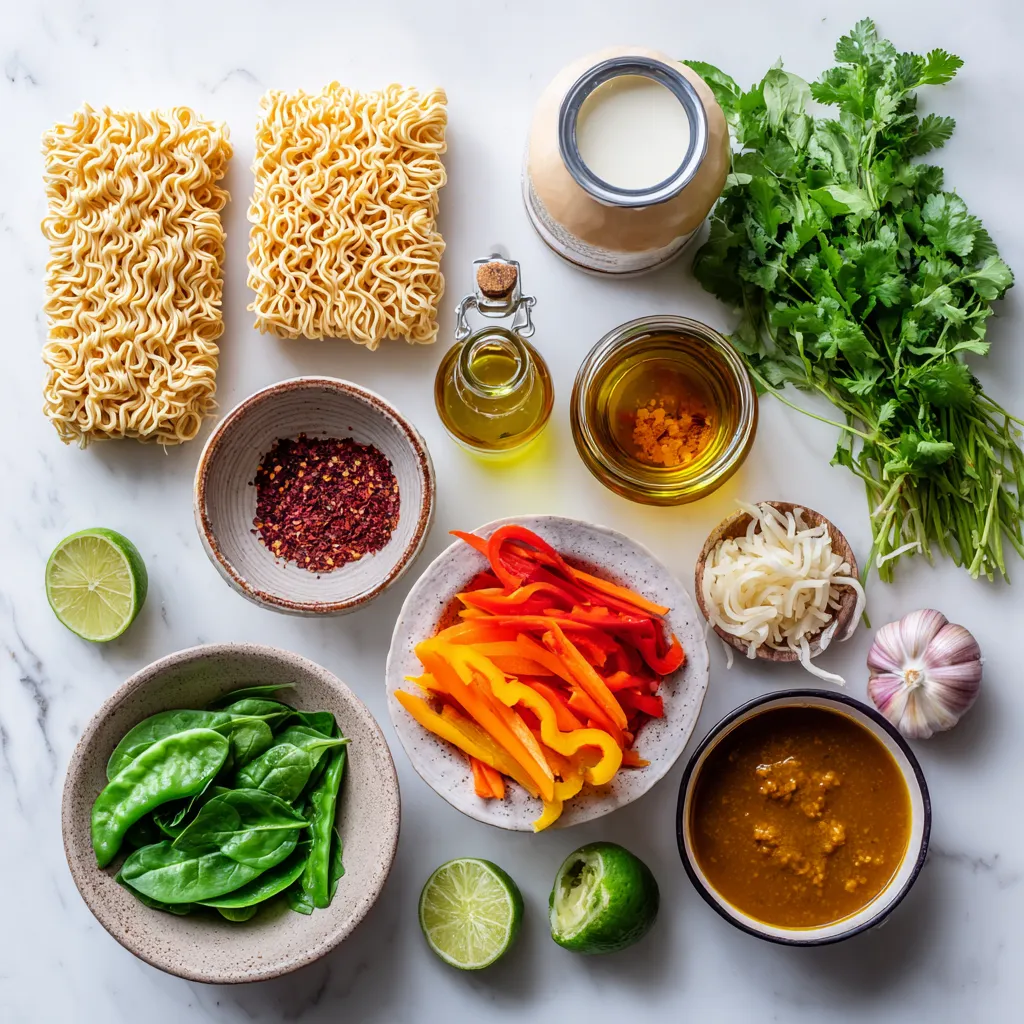
Step-by-Step Instructions
Detailed Cooking Process
1. Start by heating the olive oil in a large pot over medium heat.
2. Add the sliced onion and sauté for about 3-4 minutes until it is soft.
3. Stir in the minced garlic and grated ginger. Cook for another 1-2 minutes until you smell the great aroma.
4. Add the curry paste to the pot. Stir well to coat the onions. Cook for 2 minutes to boost the flavor.
5. Pour in the coconut milk and vegetable broth. Stir until the curry paste mixes completely. Bring this mix to a gentle simmer.
6. Once it simmers, add the sliced bell pepper, snap peas, and julienned carrot. Cook for 5-7 minutes until the veggies are tender but still crisp.
7. In a separate pot, boil water and cook the ramen noodles as per package instructions, usually 4-5 minutes. Drain them and set aside.
8. Now, add the baby spinach to the coconut curry broth. Pour in the soy sauce and lime juice. Stir until the spinach wilts.
9. To serve, place a serving of ramen noodles in a bowl. Ladle the coconut curry and veggies over the noodles.
10. Garnish with fresh cilantro and crushed red pepper flakes if you want extra heat.
Tips for Each Cooking Stage
- Heating the Oil: Make sure the oil is warm before adding the onion. This helps to release the onion’s sweetness.
- Sautéing: Keep an eye on the onion. You want it soft, not brown.
- Adding Garlic and Ginger: Stir often. Garlic burns easily, which makes it bitter.
- Curry Paste: Taste as you go. You can add more or less based on your spice preference.
- Cooking Veggies: Cut your veggies evenly. This helps them cook at the same rate.
- Cooking Noodles: Don’t forget to drain the noodles well. You don’t want a watery bowl.
- Serving: Serve hot for the best taste. The flavors blend beautifully when fresh.
Visual Aids or Process Images
*Consider adding photos at each step to guide you. Visual aids help you see the color and texture you should achieve.*
1. Photo of sautéed onions until soft.
2. Image showing the mix of curry paste with the onion.
3. Picture of the simmering broth with vibrant veggies.
4. Final shot of the bowl, topped with cilantro and red pepper flakes.
Each image helps you understand the process better. Enjoy your cooking journey!
Tips & Tricks
How to Enhance Flavor
To boost the flavors in your coconut curry ramen, start with fresh ingredients. Use ripe vegetables for more taste. Sauté the onions until soft for sweetness. Add garlic and ginger for depth. Curry paste is key here. Choose red for heat or yellow for a milder touch. Always taste as you go. Adjust with soy sauce or lime juice to balance flavors.
Cooking Techniques for Perfect Noodles
Cooking noodles properly is vital for a great ramen bowl. Boil water in a separate pot. Follow package instructions and cook noodles for 4-5 minutes. Drain them well but keep them slightly firm. Rinse under cold water to stop cooking. This keeps them from getting mushy. Add the cooked noodles just before serving for the best texture.
Making Ahead for Meal Prep
You can easily meal prep this dish. Cook the coconut curry base and store it separately. Cool it down before putting it in the fridge. This curry can last for up to three days. When ready to eat, reheat the curry and cook fresh noodles. This keeps the noodles from getting soggy. You’ll enjoy a fresh, warm meal without much hassle.
Pro Tips
- Use Fresh Ingredients: Fresh vegetables and herbs will enhance the flavor of your coconut curry ramen, making it more vibrant and delicious.
- Choose Your Curry Paste Wisely: Depending on your heat preference, select red or yellow curry paste. Red paste is generally spicier, while yellow is milder and slightly sweeter.
- Customize Your Veggies: Feel free to swap in your favorite vegetables or whatever you have on hand. Broccoli, zucchini, or mushrooms would also work great!
- Experiment with Toppings: Add extra toppings like sliced scallions, lime wedges, or toasted sesame seeds for added flavor and texture.
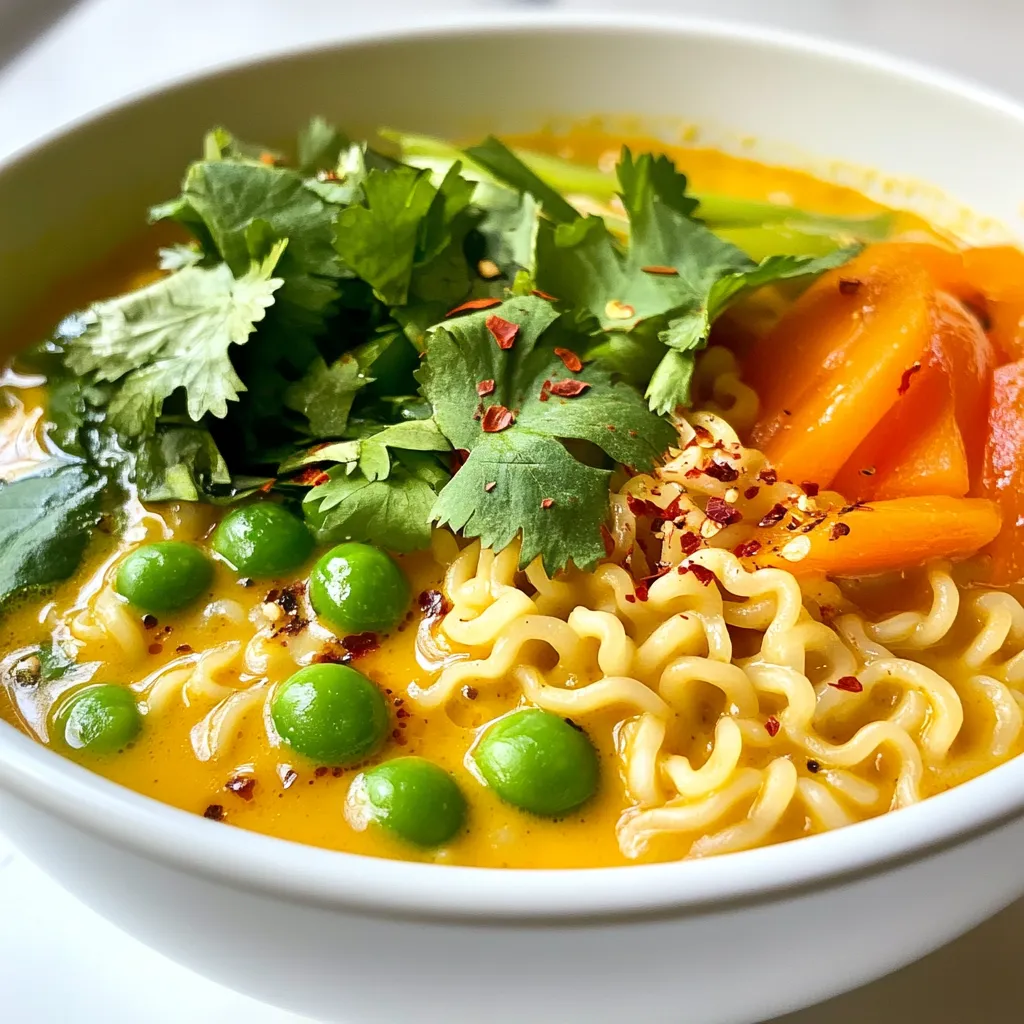
Variations
Protein Additions (Tofu, Chicken, Shrimp)
You can boost your Coconut Curry Ramen Bowl with protein. Tofu is a great choice for a vegetarian option. Just press and cube the tofu, then pan-fry it until golden. Chicken is another tasty choice. Simply cut it into bite-sized pieces and cook it in the pot with the onions. Shrimp cooks quickly, so add it just a few minutes before serving. It should turn pink and opaque.
Vegetarian/Vegan Alternatives
For a vegan dish, swap the chicken and shrimp for tofu or chickpeas. Both options add protein and flavor. Use vegetable broth to keep it vegetarian. Check the curry paste too; some brands may have shrimp paste. Always read the label to ensure it’s vegan-friendly.
Low-Carb or Gluten-Free Modifications
If you prefer low-carb, skip the ramen noodles. Instead, use zucchini noodles or kelp noodles. They add texture without the carbs. For a gluten-free version, choose gluten-free soy sauce or tamari. You can also find gluten-free ramen noodles made from rice or buckwheat. These swaps keep your dish flavorful and enjoyable.
Storage Info
Best Practices for Storing Leftovers
To keep your coconut curry ramen fresh, store it in an airtight container. Make sure it cools down first. Place the noodles and broth in separate containers. This way, the noodles won’t get soggy. Leftovers can last in the fridge for about three days. When you’re ready to eat, check for any off smells or colors.
Reheating Tips
When you reheat your ramen, do it gently. Pour the broth into a pot and heat it on medium. Once warm, add the noodles. Stir everything together to ensure even heating. You can also use a microwave, but heat it in short bursts. Stir in between to avoid hot spots. Add a splash of water if it seems dry.
Freezing Options and Limitations
You can freeze the coconut curry broth, but avoid freezing the noodles. The texture won’t be the same after thawing. To freeze, let the broth cool completely. Pour it into freezer-safe bags or containers. Label them with the date. It can last for up to three months in the freezer. When you’re ready to enjoy it, thaw it overnight in the fridge. Reheat as mentioned above for best results.
FAQs
What is the best type of ramen for this recipe?
The best ramen is fresh or dried wheat noodles. These have great texture and flavor. Instant noodles work too, but skip the seasoning packets. Fresh noodles cook fast and soak up the curry well. Dried noodles take a bit longer but are just as good.
Can I use other types of curry paste?
Yes, you can use different curry pastes! Red or yellow curry paste both work well. Each type adds its own unique flavor. Green curry paste could be a fun choice for a bolder taste. Adjust the amount to suit your spice level.
How can I make it spicier?
To add heat, use more curry paste. You can also sprinkle in crushed red pepper flakes. Fresh chopped chili peppers are a great option too. Start with a little, then taste. You can always add more spice, but it’s hard to take it out.
What can I serve alongside this coconut curry ramen bowl?
Serve this dish with a fresh salad or steamed veggies. A side of spring rolls adds a nice crunch. You can also try pickled vegetables for a tangy bite. Rice or quinoa can make it more filling if you want.
This blog post covered key ingredients and step-by-step instructions for making coconut curry ramen. I shared tips to enhance flavor and cooking techniques for perfect noodles. We also explored variations for different diets and effective storage methods.
In closing, this dish is not only simple to make but it also allows for creativity. You can adjust it to fit your taste and needs. Enjoy making this delicious rame

Coconut Curry Ramen Bowl
Ingredients
- 2 packs ramen noodles (discard the seasoning packets)
- 1 can coconut milk (13.5 oz)
- 2 cups vegetable broth
- 2 tablespoons curry paste (red or yellow)
- 1 tablespoon olive oil
- 1 onion sliced
- 2 cloves garlic, minced
- 1 inch piece of ginger, grated
- 1 bell pepper sliced (any color)
- 1 cup snap peas or green beans
- 1 carrot julienned
- 1 cup baby spinach
- 2 tablespoons soy sauce (or tamari for gluten-free)
- 1 lime juice of
- 1 bunch fresh cilantro, for garnish
- 1 teaspoon crushed red pepper flakes (optional, for heat)
Instructions
- In a large pot, heat the olive oil over medium heat. Add the sliced onion and sauté for about 3-4 minutes until soft.
- Stir in the minced garlic and grated ginger, and cook for another 1-2 minutes until fragrant.
- Add the curry paste to the pot, stirring to coat the onions, and cook for 2 minutes to enhance the flavor.
- Pour in the coconut milk and vegetable broth, stirring until the curry paste is fully blended. Bring to a gentle simmer.
- Once simmering, add the sliced bell pepper, snap peas, and julienned carrot to the pot. Cook for 5-7 minutes until the vegetables are tender but still crisp.
- In a separate pot, boil water and cook the ramen noodles according to package instructions (usually 4-5 minutes). Drain and set aside.
- Add the baby spinach to the coconut curry broth, followed by the soy sauce and lime juice. Stir until the spinach is wilted.
- To serve, place a serving of ramen noodles in a bowl and ladle the coconut curry and vegetables over the noodles.
- Garnish with fresh cilantro and a sprinkle of crushed red pepper flakes if desired for extra heat.


